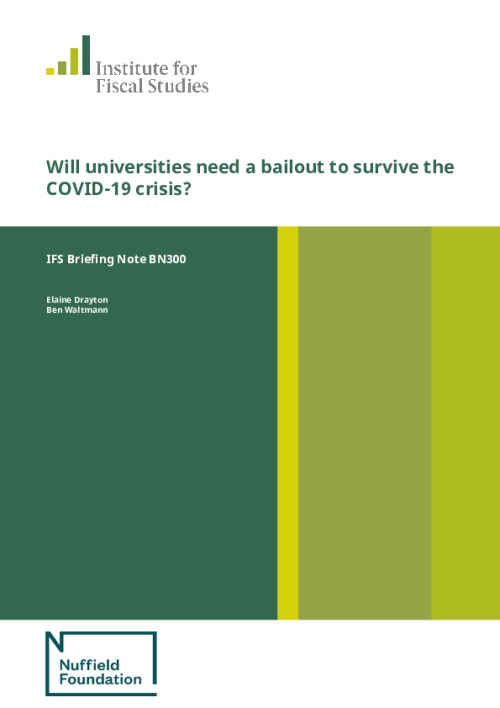The ongoing COVID-19 crisis poses a significant financial risk to the UK higher education sector. Universities are facing big losses across a range of income sources and investments. These losses could cause serious financial problems, including – in the extreme – insolvency. Most institutions will be left with reduced net assets, which could increase financing costs and will leave them less well placed to cope with future adverse shocks.
This briefing note examines the resilience of university finances to the likely consequences of the COVID-19 outbreak and the public health response to it. For UK higher education institutions, we estimate the likely financial losses associated with the crisis under three different scenarios, reflecting different crisis trajectories in the coming months. We assess the chances of insolvency and estimate the cost of potential bailouts to the taxpayer.
Our main findings are:
- The total size of the university sector’s losses is highly uncertain: we estimate that long-run losses could come in anywhere between £3 billion and £19 billion, or between 7.5% and nearly half of the sector’s overall income in one year. Our central estimate of total long-run losses is £11 billion or more than a quarter of income in one year.
- The biggest losses will likely stem from falls in international student enrolments (between £1.4 billion and £4.3 billion, with a central estimate of £2.8 billion) and increases in the deficits of university-sponsored pension schemes, which universities will eventually need to cover (up to £7.6 billion, with a central estimate of £3.8 billion). In addition, the sector faces lockdown-related losses of income from student accommodation and conference and catering operations, as well as financial losses on long-term investments.
- Large sector-level losses mask substantial differences between institutions. In general, institutions with a large share of international students and those with substantial pension obligations are most affected. These tend to be higher-ranking institutions as well as postgraduate and music & arts institutions. Some of the least selective universities, which rely largely on domestic fee income, will also be badly hit if higher-ranked universities admit more UK students to make up for the shortfall in their international enrolments. While recently introduced student number caps will constrain some of this behaviour, there are still likely to be falls in student numbers at the least selective institutions.
- Universities are unlikely to be able to claw back a large portion of these losses through cost savings unless they make significant numbers of staff redundant. In our central scenario, we estimate that cost savings could reduce the overall bill by only £600 million or around 6% without redundancies. The potential for cost savings varies across universities: institutions with a larger proportion of temporary staff will likely be able to make larger savings, but this may impact teaching quality.
- For the university sector as a whole, net losses in our central scenario are only slightly larger than five years of surplus at the pre-crisis level. Assuming that the underlying profitability of universities remains unchanged, the total financial reserves of the higher education sector could still be roughly the same in 2024 as they were in 2019, even without a government bailout.
- Whether COVID-related losses put a given institution at risk of insolvency largely depends on its profitability and its balance sheet position before the crisis, rather than on its predicted losses from COVID-19. The institutions with the highest predicted losses all have large financial buffers and are therefore at little risk of insolvency. The institutions at the greatest risk tend to have smaller predicted losses, but had already entered the crisis in poor financial shape.
- In our central scenario, 13 universities educating around 5% of students would end up with negative reserves and thus may not be viable in the long run without a government bailout or debt restructuring. A very tightly targeted bailout aimed at keeping these institutions afloat could cost around £140 million. In comparison, a one-off increase in teaching grants of £1,000 per UK/EU student would cost £1.8 billion but in our central scenario would only push three institutions above the line of zero reserves.
- There is considerable uncertainty over actual risks to institutions and a trade-off between highly targeted and more general support. And additional support might not be aimed purely at preventing insolvencies. But there is a big gap in cost between a very targeted bailout costing perhaps less than £200 million and the more generalised bailout proposed by Universities UK, which would cost £3.2 billion and at the same time provide very little support to most universities that appear to be most at risk of insolvency; according to our modelling, only two institutions would be pushed above the line of zero reserves by this proposed policy. Government will need to be very clear about the purpose of any bailout package and design it accordingly.`
- Lightly regulated Alternative Providers educate around 3% of all students in the higher education sector. Many of these providers have low reserves and rely almost exclusively on tuition fees for their income. Alternative Providers with a large share of international students are at a significant risk of insolvency, potentially leaving students unable to complete their degrees.











